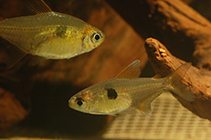| Family: |
Characidae (Characins; tetras), subfamily: Stethaprioninae |
| Max. size: |
3 cm SL (male/unsexed) |
| Environment: |
benthopelagic; freshwater; depth range 1 - 2 m |
| Distribution: |
South America: headwaters of the rio Arapiuns, rio Tapajós basin, and from the adjacent headwaters of the igarapé Juruti Grande, rio Amazonas in Brazil. |
| Diagnosis: |
Dorsal soft rays (total): 11-12; Anal soft rays: 21-25; Vertebrae: 31-31. Distinguished from all species of the genus, except Hemigrammus stictus (Durbin), by having a large single humeral spot situated from fifth-sixth to posterior margin of eighth-tenth lateral line scales. Differs from Hemigrammus stictus by having a humeral spot roughly rectangular, higher than wide, with a pronounced upper, anteriorly-oriented extension,
conferring an inverted-comma shape to the blotch (vs. humeral spot roughly rounded, not presenting an inverted-comma shape), and life color pattern presenting unpaired fins orange reddish (vs. caudal fin and caudal peduncle bright red in life, remaining fins translucent) (Ref. 81198).
Description: Dorsal-fin rays ii, 9, 10, not including small ossification anterior to first unbranched ray, discernible only in c&s specimens, absent in two out of eight c&s individuals; anal-fin rays iv, 17-21; pectoral-fin rays i, 9-11; pelvic-fin rays typically i,7, a single specimen i,8 (Ref. 81198). |
| Biology: |
Inhabits shallow marginal areas, with abundant aquatic macrophytes, both emergent and non-emergent (Ref. 81198). Gut contents of four specimens include insect larvae, winged insects and plant matter (Ref. 81198). |
| IUCN Red List Status: |
Least Concern (LC); Date assessed: 07 November 2018 Ref. (130435)
|
| Threat to humans: |
harmless |
Source and more info: www.fishbase.org. For personal, classroom, and other internal use only. Not for publication.

